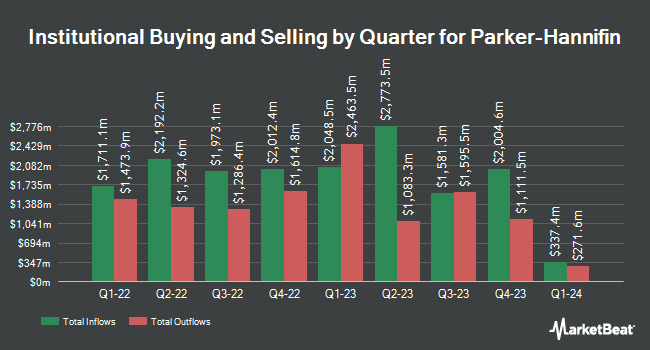California Public Employees Retirement System reduced its position in shares of Parker-Hannifin Co. (NYSE:PH - Free Report) by 5.5% in the 4th quarter, according to the company in its most recent disclosure with the Securities & Exchange Commission. The firm owned 212,732 shares of the industrial products company's stock after selling 12,263 shares during the period. California Public Employees Retirement System owned about 0.17% of Parker-Hannifin worth $135,304,000 as of its most recent filing with the Securities & Exchange Commission.
Several other hedge funds have also recently bought and sold shares of PH. Franklin Resources Inc. increased its position in shares of Parker-Hannifin by 39.2% during the third quarter. Franklin Resources Inc. now owns 645,516 shares of the industrial products company's stock worth $415,409,000 after acquiring an additional 181,859 shares during the period. Howard Capital Management Group LLC purchased a new position in shares of Parker-Hannifin in the 4th quarter valued at about $23,390,000. SG Americas Securities LLC increased its stake in shares of Parker-Hannifin by 752.5% during the fourth quarter. SG Americas Securities LLC now owns 24,381 shares of the industrial products company's stock worth $15,507,000 after buying an additional 21,521 shares during the period. Columbus Macro LLC lifted its stake in Parker-Hannifin by 485.2% in the fourth quarter. Columbus Macro LLC now owns 10,751 shares of the industrial products company's stock worth $6,838,000 after acquiring an additional 8,914 shares during the last quarter. Finally, Congress Asset Management Co. grew its holdings in Parker-Hannifin by 15.5% during the 4th quarter. Congress Asset Management Co. now owns 190,701 shares of the industrial products company's stock worth $121,292,000 after acquiring an additional 25,605 shares in the last quarter. Institutional investors and hedge funds own 82.44% of the company's stock.
Parker-Hannifin Price Performance
Shares of NYSE PH traded down $69.79 during trading on Thursday, hitting $559.19. 1,178,442 shares of the company were exchanged, compared to its average volume of 680,639. The firm's fifty day moving average price is $654.89 and its 200 day moving average price is $655.17. The company has a debt-to-equity ratio of 0.51, a current ratio of 1.06 and a quick ratio of 0.59. The company has a market cap of $71.98 billion, a price-to-earnings ratio of 23.09, a PEG ratio of 2.85 and a beta of 1.50. Parker-Hannifin Co. has a 1 year low of $492.71 and a 1 year high of $718.44.
Parker-Hannifin (NYSE:PH - Get Free Report) last issued its earnings results on Thursday, January 30th. The industrial products company reported $6.53 earnings per share for the quarter, topping the consensus estimate of $6.23 by $0.30. Parker-Hannifin had a net margin of 15.87% and a return on equity of 27.34%. On average, sell-side analysts expect that Parker-Hannifin Co. will post 26.71 earnings per share for the current fiscal year.
Parker-Hannifin Announces Dividend
The firm also recently declared a quarterly dividend, which was paid on Friday, March 7th. Shareholders of record on Friday, February 7th were issued a $1.63 dividend. This represents a $6.52 annualized dividend and a dividend yield of 1.17%. The ex-dividend date of this dividend was Friday, February 7th. Parker-Hannifin's dividend payout ratio (DPR) is presently 26.99%.
Analyst Upgrades and Downgrades
A number of research firms have weighed in on PH. Evercore ISI raised their price target on Parker-Hannifin from $777.00 to $824.00 and gave the company an "outperform" rating in a research note on Wednesday, February 19th. Barclays cut their price objective on shares of Parker-Hannifin from $791.00 to $750.00 and set an "overweight" rating on the stock in a report on Monday, March 10th. Citigroup started coverage on shares of Parker-Hannifin in a research note on Friday, February 7th. They set a "buy" rating and a $795.00 price target on the stock. UBS Group reduced their target price on Parker-Hannifin from $842.00 to $805.00 and set a "buy" rating for the company in a report on Friday, January 31st. Finally, Truist Financial increased their price objective on Parker-Hannifin from $788.00 to $842.00 and gave the company a "buy" rating in a report on Thursday, December 19th. Four research analysts have rated the stock with a hold rating and fourteen have assigned a buy rating to the company. According to data from MarketBeat.com, Parker-Hannifin currently has a consensus rating of "Moderate Buy" and an average price target of $736.65.
View Our Latest Research Report on Parker-Hannifin
Parker-Hannifin Company Profile
(
Free Report)
Parker-Hannifin Corporation manufactures and sells motion and control technologies and systems for various mobile, industrial, and aerospace markets worldwide. The company operates through two segments: Diversified Industrial and Aerospace Systems. The Diversified Industrial segment offers sealing, shielding, thermal products and systems, adhesives, coatings, and noise vibration and harshness solutions; filters, systems, and diagnostics solutions to ensure purity and remove contaminants from fuel, air, oil, water, and other liquids and gases; connectors used in fluid and gas handling; and hydraulic, pneumatic, and electromechanical components and systems for builders and users of mobile and industrial machinery and equipment.
Further Reading

Before you consider Parker-Hannifin, you'll want to hear this.
MarketBeat keeps track of Wall Street's top-rated and best performing research analysts and the stocks they recommend to their clients on a daily basis. MarketBeat has identified the five stocks that top analysts are quietly whispering to their clients to buy now before the broader market catches on... and Parker-Hannifin wasn't on the list.
While Parker-Hannifin currently has a Moderate Buy rating among analysts, top-rated analysts believe these five stocks are better buys.
View The Five Stocks Here
Almost everyone loves strong dividend-paying stocks, but high yields can signal danger. Discover 20 high-yield dividend stocks paying an unsustainably large percentage of their earnings. Enter your email to get this report and avoid a high-yield dividend trap.
Get This Free Report
Like this article? Share it with a colleague.
Link copied to clipboard.